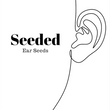
Auriculotherapy is a form of traditional Chinese medicine that focuses on the external ear also referred to as the auricle.
The practice is used to diagnose and treat many conditions such as pain, anxiety, stress, insomnia and various other medical conditions in the body.
Also referred to as Auricular Medicine, the practice can be performed as a stand alone treatment, or in conjunction with other services such as acupuncture, reflexology and massage.
Why the Ear?
Treatment of the ear has been practiced for over 2,000 years, originating in ancient China.
The methodology we use at Seeded Ear Seeds however is based on the work of Dr Paul Nogier. In the 1950’s Dr Nogier researched and mapped specific points on the ear where he found a corresponding links to various parts of the body.
Much of Dr. Nogier's original work has been verified in numerous research studies, and both Chinese and European systems are based on his work.
His research earned him the name 'The Father of Auriculotherapy’.
The practice of using ear seeds offers a safe, needle-free, painless and convenient treatment to help bring balance and promote healing.
Well known for its benefits, ‘ear seeding’ is a practice that's used widely by doctors, acupuncturists, naturopaths, dentists and wellness experts. The evidence shows that as the ear represents a micro-map of the human body, the ear can reflect disease in the body and also allow for treatment via the external ear.

Ear seeds are a great choice for helping balance energy, referred to as Qi (pronounced ch'i) as well as promoting a sense of overall wellbeing.
According to the World Health Organization (WHO) "Auriculotherapy is probably the most developed and best documented, scientifically of all the microsystems of acupuncture and is the most practical and widely used'. In 1990, Director-General Dr. Hiroshi Nakajima stated "unlike classical acupuncture which has almost entirely derived from ancient China, auricular acupuncture is, to a large extent, a more recent development that has received considerable development and contributions from the west." - Auriculotherapy is truly an 'east' meets 'west' practice that marries the best of traditional Chinese medicine with the science and detailed analysis of the west.
There are many uses for auriculotherapy such as pain control, addictions, internal maladies, emotional concerns such as stress, fatigue and overwhelm as they are thought to promote comfort and relaxation.
What's the theory behind 'ear seeding'?
Traditional Chinese medical theory (TCM) describes special acupoints, or acupressure points, that lie along meridians, or channels in the body. These are the same energy meridians and acupoints as those targeted with acupuncture. It is believed that through these channels there is a vital energy flow, or a life force called Qi.
According to this theory, when one of these meridians is blocked or out of balance, illness can occur. Acupressure and acupuncture are among the types of TCM that are thought to help restore balance. Ear seeds are a tiny seeds or pellets that are placed on points of the ear that act like tiny acupressure devises, gently placing pressure on the affected acupoint (also referred to as reflex point).

How do they work?
Ear seeds help to promote the release of natural endorphins in your body. Effectively ear seeds send signals to the brain, which then communicates to the body. To see more clinical studies for various concerns, head to our 'publication section'.
How to use your seeds
- Firstly, clean and dry the outside of your ear. Ear seeds should always go on the outside of your ear, never in your ear canal.
- Identify the correct point. Seeded Ear Seeds provides charts showing the location of specific points.
- Use tweezers to apply the ear seed to the point on your ear. Ear seeds come on adhesive tape, just twist the backing, peel the seed off and gently press onto he ear ensuring a proper stick.
- Massage ear seeds gently. It's recommend to gently massage the seeds two to three times a day or as required. Apply pressure by rubbing the seeds with a circular motion for one to three minutes.
- Change them regularly. Ear seeds will naturally fall off over three to five days. If they haven't, it's recommended you remove them after 4-5 days. At Seeded we suggest leaving a few days in-between seeding sessions to allow the body to 'reset' before your next session.
You may notice your ear seeds feeling a little tender. If the ear has 'active points' also called active reflex points, this is an indication there is an imbalance in the body. You can generally locate these by palpating for tenderness (active points are tender to pressure). It is quite normal to feel warmth or tenderness. If you experience pain, then remove your seeds and try a few hours at a time being mindful that you want to give your seeds an opportunity to work. If you have a lot of imbalance in the body, the more sensitive your ears may be. Work with your body, not against it. As the pain in your body eases, you will notice discomfort in your ears subsiding as well.
For a great tutorial, watch this Youtube video by LA based Vie Healing. Click below.
Disclaimer: Auriculotherapy, though extremely safe and beneficial, is not a substitute for qualified medical treatment. This blog is for educational and entertainment purposes only. Every attempt has been made to ensure the information contained herein is timely and accurate, but inaccuracies may exist. You are solely responsible for the verification and application of this information. For commonly asked questions, please head to our FAQ section.
Resources:
https://apps.who.int/iris/handle/10665/60870
https://www.ncbi.nlm.nih.gov/pmc/articles/PMC6604909/
https://www.auriculo360.com/what-is-auriculotherapy/
https://www.webmd.com/balance/ear-seeds-what-to-know
